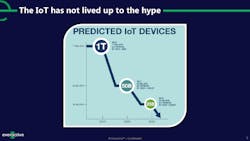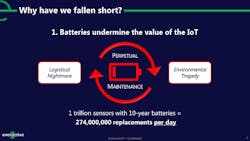Are batteries limiting more widespread adoption of digital tech?
Peter Woodman leads sales engineering, solution design, and training at Everactive, and is a leading advocate for battery-less sensing in the industrial internet of things. During the live Q&A portion of the webinar, "How to Overcome the IoT's Battery Problem for Maintenance and Reliability," Woodman tackled several attendee questions on the advantages of self-powered IoT devices.
PS: Since Everactive sensors do not use batteries, does that mean that data is only transmitted sporadically?
PW: The answer is no. We don't use batteries because batteries fail. There's a limited number of charge cycles. They lose their hot top capacity first, like your cell phone battery. After a couple of years, you don't get as much out of it. Then eventually the battery will fail entirely and won’t work at all.
We do use capacitors on our devices. The difference is that capacitors are much simpler devices that don't wear out in the same way. We can store some energy. For example, if you have a process that goes up and down, instead of just transmitting sporadically, we can store energy and then use that capacitor to run through the night.
While we're running, we do transmit continuously. But even if we don't have any energy present for some reason, we can run off that capacitor and continually transmit.
PS: What types of energy harvesters do you use, and how much power do they require?
PW: We did have a slide that showed all four of the harvesting modalities we're currently working on. One of the most popular ones today is temperature difference. For example, something that's warmer than something else or colder than something else by 2-3°C or 15-20°F. That in and of itself is enough to spin our sensors up and get them running on the solar side, which is the other popular harvester we're deploying at scale today. The measurement of light is called lux, and we say about 200 lux is the baseline.
PS: In your presentation, you said that transformation represents a disruption in conventional lanes of putting sensors out there, especially remote sensors. Can you talk about the ways it's going to penetrate the market?
PW: We have several different types of customers who approach us. Some of them are reliability managers who say, "I have been struggling with this steam trap problem for years and years." Some of them are innovation directors or IT-focused people who say, "We have been struggling to get actionable data into our platforms."
The nice thing about our solution is that it helps both. It gives you a huge data lake that makes the innovation and data science people happy, but it also keeps the trains running on time from a maintenance and reliability standpoint.
PS: What we're hearing in the field is that facilities are not really sure how to get started. Something like this, which is a quick installation, would be pretty intriguing, especially for those who thought that the IoT really wasn't for them.
PW: I think it's intriguing for a lot of people because it takes something off their plate very quickly in a very straightforward way. They were dealing with a manual PM, or paying a contractor to come in and handle this part of their business for them. And now, we're taking all those footsteps off the plate. They’re only reacting to things that they know need attention.


